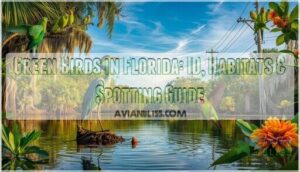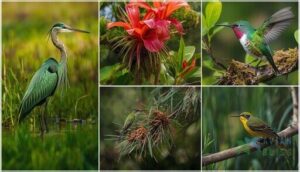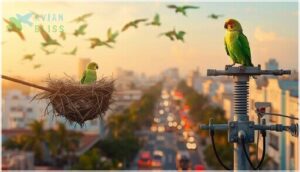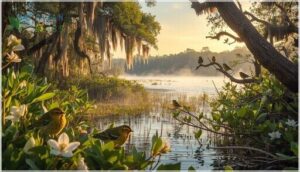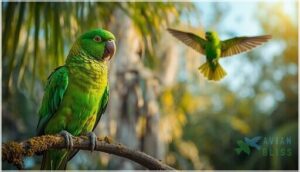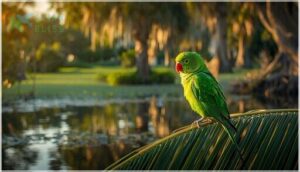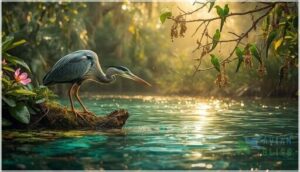This site is supported by our readers. We may earn a commission, at no cost to you, if you purchase through links.
You might think Florida’s only famous for its flamingos and pelicans, but the state hosts over 35 species of green birds—from tiny hummingbirds to raucous parakeets that escaped the pet trade decades ago.
The Green Heron stalks fish in your local wetlands while Monk Parakeets build apartment-style nests on power lines, causing blackouts that cost utilities millions each year.
These emerald residents range from native warblers that migrate through coastal corridors each spring to tropical parrots now thriving in Miami’s urban canopy.
Whether you’re spotting a Ruby-throated Hummingbird at your feeder or hearing squawking parakeets overhead, understanding these green birds helps you identify what’s native, what’s invasive, and where to find Florida’s most vibrant avian residents.
Table Of Contents
- Key Takeaways
- Common Green Birds in Florida
- How to Identify Green Birds
- Habitats and Distribution in Florida
- Diet, Behavior, and Ecological Roles
- Birdwatching and Conservation Tips
- Frequently Asked Questions (FAQs)
- What kind of bird is green in Florida?
- What are the green parrot like birds in Florida?
- What are the little green birds?
- Are parakeets invasive in Florida?
- Are green iguanas considered green birds in Florida?
- Can I remove green iguanas from my property?
- How do I pay tolls on Floridas Turnpike System?
- What is Gaintime and who should I contact with questions?
- What diseases affect green birds in Florida?
- How do green birds communicate with each other?
- Conclusion
Key Takeaways
- Florida hosts over 35 species of green birds split into three groups—natives like the Green Heron and Ruby-throated Hummingbird, invasive populations such as Monk Parakeets that cause millions in power outage costs, and seasonal migrants like warblers passing through coastal corridors each spring and fall.
- You can identify green birds by watching for key features like iridescent versus pigmented greens, male-female plumage differences (males show brighter colors), distinctive calls ranging from the Green Heron’s harsh skeow to parrots’ loud squawks, and behavioral clues like the Green Heron’s clever tool use when baiting fish with feathers.
- Green birds play vital ecosystem roles through seed dispersal that connects isolated habitats, natural pest control protecting over 9 million acres of Florida farmland, and maintaining plant biodiversity—though invasive parrots compete with native species for resources and nesting sites.
- You’ll boost your chances of spotting green birds by visiting hotspots like Fort De Soto Park (352 recorded species) and Everglades National Park, attracting them to your yard with native plants like firebush and black oil sunflower seeds, and supporting conservation efforts since nearly half of Florida’s coastal and forest birds have lost over 50% of their populations in fifty years.
Common Green Birds in Florida
Florida’s green birds fall into three main groups: the natives that have always called this place home, the newcomers that arrived from somewhere else, and the seasonal visitors that pass through during migration. Each group brings its own story to the Sunshine State’s skies.
Let’s start with the birds you’re most likely to spot year-round.
Native Green Bird Species
Florida’s native green birds bring life to the state’s ecosystems year-round. These species play important ecological roles in habitat preservation and population trends:
- Green Heron (Butorides virescens) – Wetland hunter with rich greenish plumage
- Ruby-throated Hummingbird (Archilochus colubris) – Primary native hummingbird statewide
- Northern Parula (Setophaga americana) – Year-round resident with greenish back
- Black-throated Green Warbler (Setophaga virens) – Seasonal migrant through Florida
Identifying green birds starts with understanding these native Florida bird species. Conservation efforts are key to protecting green bird populations from habitat loss.
Introduced and Feral Green Birds
While native species play key ecological roles, you’ll also encounter feral parrots throughout the state—particularly in South Florida. Monk Parakeets are the most common, with over 35 parrot species sighted in Miami-Dade County alone. These feral populations stem from pet trade escapes and thrive in urban ecology.
Florida’s climate and geography make it parrot’s ideal location. Though beloved by many, invasive species create economic costs through power outages and compete with native birds for resources.
Seasonal and Migratory Green Birds
Beyond year-round residents, you’ll spot seasonal visitors during spring and fall migrations. Peak migration patterns run April through May and September through October, when thousands of green birds—like Black-throated Green Warblers and Tennessee Warblers—funnel through Florida’s east coast corridor.
These migratory birds use wetlands and forests as critical stopover sites, refueling before continuing their journeys. Conservation status varies, with habitat loss threatening several notable species during their migratory behavior cycles.
How to Identify Green Birds
Spotting a flash of green in Florida’s trees or wetlands is one thing—but figuring out exactly what you’re looking at takes a closer look. The key is knowing what to watch for, from subtle color patterns and body shapes to the differences between males and females.
Let’s break down the main features that’ll help you nail down an ID with confidence.
Key Plumage and Coloration Features
When you’re trying to identify green birds in Florida, plumage coloration tells the real story. Some species show iridescent greens created by light bouncing off feather structures—think of the Green Heron’s shimmering back. Others display pigment types like carotenoids that produce olive or lime shades.
Watch for distinctive markings, seasonal changes in brightness, and camouflage strategies that help these birds blend into vegetation.
Male Vs. Female Identification
How do you tell males from females among Florida’s green birds? Look for plumage differences first—males generally flash brighter greens while females wear muted tones for camouflage. Size morphology matters too; males often sport larger bodies or longer tails.
Behavioral indicators like courtship displays and territorial singing help with male bird identification. Seasonal variation complicates things, as breeding plumage intensifies these differences during spring.
Bird Songs and Calls
What songs help you identify Florida’s green birds? Bird vocalizations offer reliable acoustic monitoring clues. Green Herons emit harsh skeow calls in wetlands, while feral parrots produce loud squawks with vocal mimicry of urban sounds. Northern Parulas sing high-pitched, bubbly notes. You’ll notice seasonal changes too—song variation peaks during breeding season but declines by late summer. Listen for pitch, rhythm, and repetition patterns in bird songs to confirm species:
- Green Heron: explosive, abrupt alarm calls
- Wild parrots: piercing, long-distance screeches
- Northern Parula: rapid 1-2 second musical warbles
- Dawn/dusk: peak vocal activity periods
- Spring intensity: highest call frequency
Habitats and Distribution in Florida
Finding green birds in Florida depends on knowing where to look. Different species prefer different environments, from quiet wetlands to busy city parks.
Let’s explore the main habitats where you’re most likely to spot these vibrant birds across the state.
Wetlands and Marshes
Florida’s wetlands and marshes are like nature’s cafeterias for green birds—you’ll spot Green Herons hunting along the edges and Green-winged Teals paddling through shallow waters. These habitats support healthy bird populations through careful water management and habitat restoration efforts.
Marsh conservation protects critical breeding grounds where vegetation meets open water—perfect for ambush hunters like Green Herons. Bird migration patterns depend on these protected spaces, especially during winter months when populations swell. Wetland ecology thrives when water levels fluctuate naturally, creating the mixed habitat green birds need for nesting and foraging.
| Wetland Site | Green Bird Species |
|---|---|
| Green Cay Wetlands | Green-winged Teal, Green Heron |
| Wakodahatchee Wetlands | Green Heron, Neotropic Cormorant |
Urban and Suburban Areas
You’ll find Florida’s most vibrant urban bird diversity in cities like Miami and St. Petersburg, where Monk Parakeets build massive stick nests on power poles and transformers. These feral populations show striking adaptive behaviors—from problem-solving to vocal mimicry—while coexistence challenges emerge as community monitoring groups track their expansion.
Green birds thrive in parks, residential streets, and shopping centers, creating unexpected wildlife encounters in everyday suburban areas.
Forests and Woodlands
You can spot green woodland residents like the Northern Parula and Black-throated Green Warbler in deciduous and mixed hardwood forests throughout Florida. These bird habitats include longleaf pine stands and hardwood hammocks, where habitat fragmentation challenges conservation trends.
Forest bird ID requires observing nesting behaviors—Green Herons along wetland edges and communal Monk Parakeets in woodland clearings. Their ecological roles in seed dispersal and pest control make green bird species in Florida essential ecosystem players.
Regional Hotspots for Green Birds
You’ll find the best birdwatching in Florida at Fort De Soto Park, which holds 352 recorded species—making it the state’s top hotspot for green bird species in Florida.
South Florida wetlands like Everglades National Park attract over 100,000 nesting wading birds annually, while Central Florida sites including Orlando Wetlands support migration patterns for 220+ species.
Coastal hotspots and urban habitats provide year-round viewing opportunities.
Diet, Behavior, and Ecological Roles
Green birds in Florida aren’t just beautiful—they’re hardworking members of the ecosystem. From the clever Green Heron that uses tools to catch fish to the Monk Parakeet munching on backyard seeds, each species has its own way of finding food and getting by.
Let’s look at what these birds eat, how they behave, and the important jobs they do in Florida’s environment.
Feeding Habits and Diets
When you’re watching green birds in Florida, you’ll notice their bird diets reflect what’s available around them. Diet composition varies by species, with different nutritional needs driving their foraging strategies. Here’s what you should know about bird feeding habits:
- The Green Heron hunts small fish, frogs, and aquatic insects using sit-and-wait tactics at water edges
- Parakeets and parrots favor fruits, seeds, and berries from fruiting trees, aiding seed dispersal across habitats
- Seasonal trends shift diets toward more seeds in winter when insects become scarce
- Feral impact includes introduced species competing for food resources with native populations
Tool Use and Unique Behaviors
Beyond bird feeding habits, you’ll witness fascinating tool use in birds right here in Florida. Green Herons rank among the world’s smartest birds, dropping feathers or insects as bait to lure fish closer—a rare cognitive adaptation.
Florida’s Green Herons drop feathers and insects as bait to lure fish—one of nature’s cleverest hunting tricks
Meanwhile, Monk Parakeets form social pandemoniums in urban areas, building massive communal nests on utility poles. These parakeet nesting behaviors and urban adaptations showcase notable problem-solving abilities.
Role in Seed Dispersal and Pest Control
These birds aren’t just pretty—they’re ecosystem workers. Parrots and parakeets in Florida help plants spread by eating fruits and depositing seeds miles away, aiding plant population dynamics across wetlands and forests. Meanwhile, insect-eating species provide natural pest control methods, reducing the need for chemicals on farms.
- Waterfowl dispersal impact connects isolated wetlands, moving hundreds of seeds daily
- Agricultural benefits include protecting over 9 million acres of Florida farmland
- Seed dispersal by birds maintains biodiversity and aids habitat restoration
Birdwatching and Conservation Tips
If you’re hoping to spot green birds in Florida—or help protect them—you’ll want to know where to look and what you can do.
Whether you’re setting up feeders in your backyard or planning a trip to a local hotspot, small actions make a real difference.
Here’s how to get started with both birdwatching and conservation.
Best Places to Spot Green Birds
Florida’s diverse landscape puts you right where green birds thrive. Wildlife refuges, urban parks, and coastal areas across the state offer unique opportunities to spot these vibrant species. Identifying Florida birds becomes easier when you know their habitat preferences.
| Location Type | Green Birds You’ll See | Best Season |
|---|---|---|
| Wildlife Refuges | Green Herons, Teals | Year-round |
| Urban Parks | Monk Parakeets, Nanday Parakeets | Year-round |
| Coastal Areas | Black-throated Green Warblers | Spring/Fall |
Wildlife refuges like Merritt Island host over 330 species, including green-winged teals. Urban parks in Miami shelter noisy Monk Parakeet flocks, while coastal areas like Fort De Soto attract migrating warblers. Nature reserves and bird sanctuaries provide reliable birdwatching opportunities across the state.
Attracting Green Birds to Your Yard
With native landscaping, you’ll increase avian diversity in your yard by up to 32%. Plant firebush or Simpson’s Stopper—the red berries attract multiple species.
Bird feeders stocked with black oil sunflower seeds boost Painted Bunting visits by 70%. Add a shallow birdbath near shrubs, and you’ll nearly double green bird presence.
Garden structure matters: Create vertical layers from ground cover to canopy, and seasonal adjustments like supplemental feeding during migration keep them coming back.
Conservation Status and Protection Efforts
While nearly half of Florida’s coastal and forest birds have lost over 50% of their populations in fifty years, you can support conservation efforts that make a real difference.
Habitat preservation through the Florida Wildlife Corridor protects 85,517 acres for green birds. The $23 billion Everglades restoration program targets threatened species, and regulatory compliance now controls feral populations like monk parakeets through updated permitting requirements.
Frequently Asked Questions (FAQs)
What kind of bird is green in Florida?
Ever wondered which feathered friends sport emerald plumage? You’ll spot several green bird types here, from native Green Herons to introduced Monk Parakeets.
Identification of Florida birds includes noting plumage variations and size comparison among parrot and parakeet species.
What are the green parrot like birds in Florida?
You’ll mostly spot Monk Parakeets, Nanday Parakeets, and Red-crowned Amazons—feral populations thriving across Florida’s cities.
These green parrots build communal nests, feast on backyard fruits, and rival native birds for resources.
What are the little green birds?
Several small green birds visit Florida, including warblers like the Northern Parula and Black-throated Green Warbler. You’ll also spot juvenile Painted Buntings showing greenish plumage before males develop their colorful feathers.
Are parakeets invasive in Florida?
Yes, parakeets are invasive in Florida. Monk Parakeets, in particular, have established large feral populations since the 1960s, causing power outages and competing with native wildlife for resources and nesting sites.
Are green iguanas considered green birds in Florida?
No, green iguanas aren’t birds—they’re invasive reptiles in Florida. This taxonomic classification matters for legal status and ecological impact.
Proper green bird identification helps prevent iguana misidentification, shaping accurate public perception of exotic and invasive species statewide.
Can I remove green iguanas from my property?
Absolutely—you can humanely remove green iguanas from your property year-round without a permit. Florida classifies them as invasive, not protected under wildlife laws. Just follow humane methods and avoid relocation.
How do I pay tolls on Floridas Turnpike System?
For toll payments, you’ve got three roads to choose from: SunPass savings with cashless tolling, Toll-By-Plate fees via license plate cameras, or traditional cash at select plazas.
What is Gaintime and who should I contact with questions?
Gain time refers to sentence reductions Florida inmates earn through good behavior and program participation.
For questions about gain time definition, incentive eligibility, contact information, statutory references, or recent developments, reach out to the Florida Department of Corrections directly.
What diseases affect green birds in Florida?
Several threats impact these avian species: Avian Influenza spreads through waterfowl, Psittacosis bacteria affects parakeets, neurotoxic algae causes brain disease, parrot viruses strike captive populations, and mosquito diseases circulate through Florida’s ecosystem, challenging conservation efforts.
How do green birds communicate with each other?
Like neighborhood gossip traveling over backyard fences, green birds rely on vocal communication to share everything that matters. They use songs, screeches, and calls to defend territories, coordinate flocking behavior, and maintain social patterns within their groups.
Conclusion
Florida’s green birds thrive in backyards yet remain invisible to most residents. Once you learn the difference between a Green Heron’s patient stalk and a Monk Parakeet’s chaotic flock, you’ll spot them everywhere.
Whether you’re identifying native warblers or tracking invasive parrots, understanding green birds in Florida transforms ordinary walks into discovery missions.
Grab your binoculars, visit a nearby wetland, and watch these emerald residents reveal the wild biodiversity hiding in plain sight around your neighborhood.

